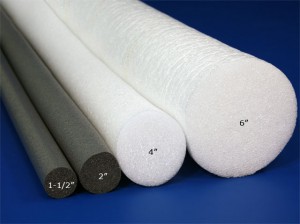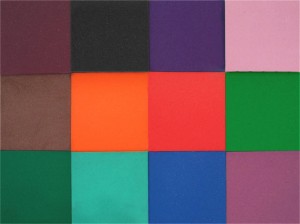A community based around imagination, integrity, and ingenuity, Live Action Role-Play (LARP) participants weave tales and stories into interactive game scenarios. Those involved, often called LARPers, act out fictional situations in a real-world setting while playing detailed character roles. Predominantly based in fantasy realms or focused around a time period, one of the major components of LARPing and perhaps the most recognized, is the simulated hand-to-hand combat within the confines of the story. As these game scenarios have themes and parameters, many battles include weaponry to facilitate the realism and interaction of the event.

With fun being the goal of these games, safety is a top priority. As a result, weaponry is constructed of contact-safe materials that must pass a strict admission test by those governing the event before use in battle. Weaponry is often homemade and constructed of foam materials wrapped around solid bases for padded impact that allows participants battle simulation without fear of injury. Foam Factory, Inc. manufactures many materials that provide vast customization possibilities for role-playing games while maintaining the safety of all participants.
The two combat accessories used most often are swords and shields. LARP swords can range in detail from little more than foam tubes with handles to layered and sculpted works of art, with the same range of styles for shields. While appearance is a major part of the fun of LARP, the safety of these weapons remains the focus during creation. One of the best basic materials for maintaining shape and durability while providing a soft, shock absorbing surface is polyethylene foam.
Available in sheet form, polyethylene is resilient closed-cell foam that is available in five different densities, from 1.7 pounds up to 9 pounds, and thicknesses from ¼ inch to 2 inches, able to be laminated together for additional thickness. These polyethylene sheets are perfect for creating armor and shield cores as they are lightweight, hold their shape, effectively absorb weapon blows, and come in sizes as large as 48 by 108 inches, down to 24 by 54 inches. These shields can be tightly covered in decorative fabric because of the rigidity of the material, without pinching or bunching along the edges.
Polyethylene tubing is also available in varying diameters and lengths, excellent for forming the “blades” of role-playing foam swords. Cores that form the structure of swords and keep them from flexing in use are often made of PVC piping or fiberglass shafts found in golf clubs. Foam is then layered around the core to the desired thickness and design. For edge-free LARPing weapons, rounded polyethylene cylinders are used, commonly seen in the form of pool noodles. Foam Factory offers these cylinders in diameters of 1-1/2 to 6 inches and lengths of 17, 35 and 70 inches. As a solid cylinder, these can be bored out by the user to the exact size of the foundation/base for a tight fit that allows any core size to be used. For holding these closed-cell foam forms together, Foam Factory offers spray adhesive specially designed for this foam type. For thrusting tips on swords or spears, soft, impact absorbing open-cell craft foam is also available. It should be noted that for optimum safety, polyethylene weapons are often wrapped in fabric or tape.
Beyond basic weaponry, Foam Factory stocks other closed-cell foam materials that can be added to the costume or accessory repertoire of any LARPer. Sheets of neoprene and polyethylene roll foam are available for creating personalized costuming and body armor, as are thicker sections of fine-celled cross-linked polyethylene (XLPE) for sculpting durable, intricate items.

Both polyethylene roll and neoprene are moisture resistant, available in regular and high density and in ultra-thin sheets down to 1/8 of an inch thickness for creating lightweight foam armor, foam padding, or wrapping weapons. There are slight differences between the two foam wrap materials however, that can lend them to different applications depending on the user’s preference. Polyethylene roll possesses a smoother, shinier surface and an irradiation cross-linked molecular structure, available in 60 inch widths that can be ordered by the lineal foot or in 50 or 100 foot rolls. Neoprene is slightly more flexible and features a matte surface appearance and is resistant to ozone, sunlight and oxidation. It is offered in full sheets measuring 48 by 80 inches and half sheets of 24 by 80 inches. Gym rubber is also available in thin sheets with similar qualities, including excellent shock absorption or weapons based around a layered sheet approach.
XLPE is an extremely fine-celled carving foam material with a smooth feel, two densities, and seven different colors. It is impervious to moisture, mildew, and mold, and sheets can be cut or laminated to any thickness desired. This color foam is excellent for those interested in sculpting highly-detailed accessories, as XLPE can be cut at home, layered, sanded, taped, and even shaped with a Dremel tool for custom foam apparel and weapons.
Regardless of the type of live games you partake in, be they medieval-based, fantasy, futuristic or something else, they are a fantastic way to get active, meet people, and have fun. The creation of your own LARP weapons is also an excellent way to express your personality and creativity. Let Foam Factory help you with the fabrication of your own set of gear that lets you express yourself while maintaining the safety that is paramount.
Note: Foam Factory, Inc. will not have any liability to anyone for incidental or consequential damages or any other liability, injury, loss or damage arising out of or related to our products, even if Foam Factory or an authorized representative of Foam Factory has been advised of the possibility of such damages.


I am looking to make a shield for boffing (LARP), and want to know which type of foam to use. I would like to to hold a rigid shape, but some ability to bend or compress slightly. It would not be the type of foam that could come in a roll. But it would NOT be totally rigid like a Styrofoam cooler or house construction 4’x8′ foam sheets. I am thinking it would be 2″ thick cross linked polyethylene. Would that be what I am thinking of?
The foam that is typically recommended for this application is either our 2lb Crosslinked Polyethylene foam or our Minicel T200 foam.
I am wanting to make a LARP Kitana. What type of foam do you recommend?
The foam that is typically recommended for this application is either our Minicel T200 or our 2lb Crosslinked Polyethylene foam.
I’m looking to replicate some LARP swords I have from a camp. The foam blade is open cell lightweight foam that comes in sheets 2-1/4″ inches thick and at least 3 feet wide. The camp counselors cut them into long (~3′) triangle shaped blades then hot glue a pvc pipe handle into the base of the triangle and soften/trim the edges a bit. So, the dimensions of the sheet would be 2.25″ thick, at least 3′ wide and ? feet long (will impact how many swords I can make out of each sheet). Thank you in advance for your advice!
Please Contact Usfor more information regarding your inquiry.
Do you know the best foam for LARP arrow tips? We were thinking about layering the 1/2” thick polyethylene foam roll and capping it with 3x3x3” charcoal foam blocks. Thanks!
Thank you for reaching out to us via Foam by Mail via our blog.
Per your question, the Polyethylene foam will work as the outer layer for this application. We have also seen other customers use the Neoprene foam as well.
You will then want to use a softer Polyurethane foam for the middle, for example the Charcoal Foam. This will provide the “squishy” feeling you would be looking for.
However, you will need to make sure it is thick enough that the arrow shaft won’t break through easily. This can typically be prevented with a “skin” for example, duct tape.
Please let me know if you have any other questions!
Hello, I am looking for foam for a particular larping use case. I would like to make a larp boffer that glows via led lights contained within the prop itself. I believe that I would need a type of foam that is strong enough that it will not break down over 1000s of repeated strikes, is soft enough to not overly damage someone when it comes into contact with them and also allows the light of the led light through to have the glowing effect that I desire. Would appreciate any thoughts on foam types that would work for this. Thank you!
Hello Alex,
If you are trying to make a useable prop meant for contact, I personally would not recommend adding LED’s as the impact can damage and short our your wires – this is typically only good for cosplay props only. I would suggest making one for combat without LED’s and one with LED’s for photo prop use.
As for the foam, EVA or our 2LB Cross Linked Polyethylene is the most common and popular used and holds up fairly well to impact, You can also use the 4LB which is a little firmer, going denser would be overkill.
To get the LED’s to shine through, you would need to carve in channels or layers of foam for the LED’s to sit in and use either another sheer material or the thinnest Polyethylene (Pool Noodle Material – I have seen cosplayers make floating wings with it) for it to have a soft glow look to it when lit up. for references, you can look up on Youtube – Kamui Cosplay; her expertise is LED weapons for cosplay and one of the most recommended for tutorial builds.